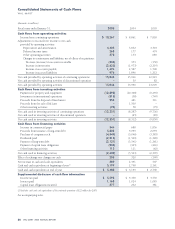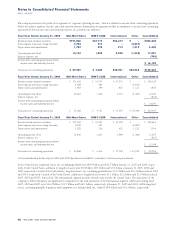Walmart 2005 Annual Report Download - page 43
Download and view the complete annual report
Please find page 43 of the 2005 Walmart annual report below. You can navigate through the pages in the report by either clicking on the pages listed below, or by using the keyword search tool below to find specific information within the annual report.
WAL-MART 2005 ANNUAL REPORT 41
3 Financial Instruments
The company uses derivative financial instruments for hedging and
non-trading purposes to manage its exposure to interest and foreign
exchange rates. Use of derivative financial instruments in hedging
programs subjects the company to certain risks, such as market and
credit risks. Market risk represents the possibility that the value of
the derivative instrument will change. In a hedging relationship, the
change in the value of the derivative is offset to a great extent by the
change in the value of the underlying hedged item. Credit risk
related to derivatives represents the possibility that the counterparty
will not fulfill the terms of the contract. The notional, or contractual,
amount of the company’s derivative financial instruments is used to
measure interest to be paid or received and does not represent the
company’s exposure due to credit risk. Credit risk is monitored
through established approval procedures, including setting concen-
tration limits by counterparty, reviewing credit ratings and requiring
collateral (generally cash) when appropriate. The majority of the
company’s transactions are with counterparties rated “AA-” or
better by nationally recognized credit rating agencies.
Fair Value Instruments
The company enters into interest rate swaps to minimize the risks
and costs associated with its financing activities. Under the swap agree-
ments, the company pays variable-rate interest and receives fixed-
rate interest payments periodically over the life of the instruments.
The notional amounts are used to measure interest to be paid or
received and do not represent the exposure due to credit loss. All of
the company’s interest rate swaps that receive fixed interest rate
payments and pay variable interest rate payments are designated as
fair value hedges. As the specific terms and notional amounts of the
derivative instruments exactly match those of the instruments being
hedged, the derivative instruments were assumed to be perfect
hedges and all changes in fair value of the hedges were recorded
on the balance sheet with no net impact on the income statement.
Net Investment Instruments
At January 31, 2005, the company is party to cross-currency interest
rate swaps that hedge its net investments in the United Kingdom
and Japan. The agreements are contracts to exchange fixed-rate
payments in one currency for fixed-rate payments in another cur-
rency. The company also has outstanding approximately £2.0 bil-
lion of debt that is designated as a hedge of the company’s net
investment in the United Kingdom. All changes in the fair value
of these instruments are recorded in other comprehensive income,
offsetting the foreign currency translation adjustment that is also
recorded in other comprehensive income.
Cash Flow Instruments
The company is party to a cross-currency interest rate swap to hedge
the foreign currency risk of certain foreign-denominated debt. The
swap is designated as a cash flow hedge of foreign currency
exchange risk. The agreement is a contract to exchange fixed-rate
payments in one currency for fixed-rate payments in another currency.
Changes in the foreign currency spot exchange rate result in reclassi-
fication of amounts from other accumulated comprehensive income
to earnings to offset transaction gains or losses on foreign-denomi-
nated debt. The instrument matures in fiscal 2007.
The company expects that the amount of gain or loss existing in
other accumulated comprehensive income to be reclassified into
earnings within the next 12 months will not be significant.
Fair Value of Financial Instruments
Instrument Notional Amount Fair Value
Fiscal Year Ended January 31, (in millions) 2005 2004 2005 2004
Derivative financial instruments designated for hedging:
Receive fixed-rate, pay floating rate interest rate swaps designated as fair value hedges $ 8,042 $ 8,292 $ 477 $ 697
Receive fixed-rate, pay fixed-rate cross-currency interest rate swaps designated
as net investment hedges (Cross-currency notional amount: GBP 795 at
1/31/2005 and 1/31/2004) 1,250 1,250 (14) 29
Receive fixed-rate, pay fixed-rate cross-currency interest rate swap designated
as a cash flow hedge (Cross-currency notional amount: CAD 503 at
1/31/2005 and 1/31/2004) 325 325 (87) (54)
Receive fixed-rate, pay fixed-rate cross-currency interest rate swap designated
as a net investment hedge (Cross-currency notional amount: ¥52,056 at
1/31/2005 and 1/31/2004) 432 432 (68) (46)
Receive floating rate, pay fixed-rate interest rate swap designated
as a cash flow hedge 1,500 1,500 (5) (16)
$11,549 $11,799 $ 303 $ 610
Non-derivative financial instruments:
Long-term debt $23,846 $20,006 $25,016 $21,349
























